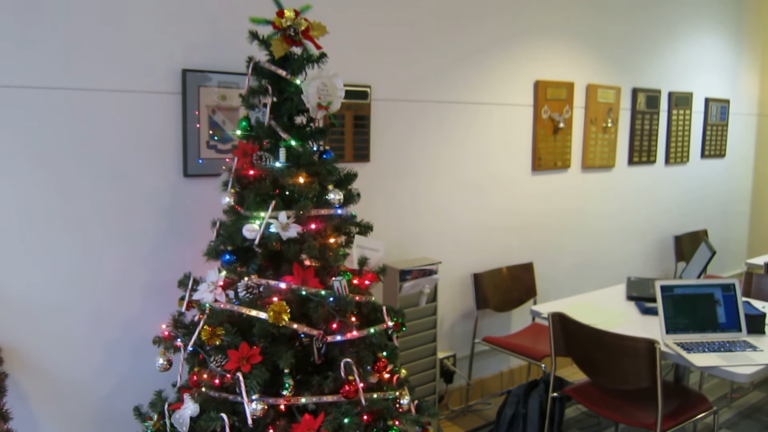Imagine having the ability to personalize your Christmas tree
lights. When the holiday is approaching and its time for your
family tradition of picking a tree, baking cookies, and putting on
the garland, lights, ornaments, and big star on top, it seems like
there is always something wrong with the lights! A few bulbs have
gone out, some are missing, and you find yourself scrambling around
trying to find replacements to put in to make sure your tree still
shines bright next holiday season.
A holiday humbug situation like this is just what Mark Yoder and the
students in his electrical and computer engineering (ECE) class at
Rose-Hulman Institute of Technology were trying to avoid when they
turned a string of Adafruit digital RGB LEDs into lights for the
department Christmas tree.
Marks students created a kernel driver, Blockly interface, and the
necessary programs to control the LED string. With the collaborative
work of Mark and his students, the ECE Christmas tree lights were
born.
The Adafruit digital RGB LED strings, with the help of the
Sitara-processor-powered
BeagleBone Black open-source computer, make it possible to set each LED
to a color and intensity. The ECE Christmas tree lights are two
five-meter Adafruit strings interfaced to the BeagleBone Black computer.
Adafruit LED strings carry 32 RGB LEDs per meter, and allow each
LED to be programmed and controlled individually. The strings are
weatherproof and easily able to be cut with some wire cutters. The
ECE Christmas tree light strings are powered at 3.3V from BeagleBone
Black, which is powered with a 5V external supply.
BeagleBone Black was chosen to work with the lights because it is
inexpensive and capable of an assortment of tasks at high
performance. By putting it with the Adafruit LED strings, fun and
unique light displays can be made! You can see these lights in
action:
One of my favorite displays starts an LED at the bottom of the
string and sequences it up to the top, Mark said. It starts a dim
red and as it moves along, it gets brighter and brighter. The LED
represents someone sledding and they are getting hotter and hotter
as they climb the hill. One of these sledders is started every two
seconds and the whole collection is a sledding party. Once they
reach the top, they turn around and sled down, getting bluer and
bluer and colder as they go.
Even though the tree has been taken down until next Christmas,
students have requested to keep the LEDs on display to play with on
study breaks and create new light patterns.
Mark has different pattern examples written in C, python, shell
scripts, and JavaScript. A challenge he faces is finding enough
time to play with the LED string. It doesnt take long to
implement a new pattern, but once you get it going you think of
other, cooler, things to do.
While the holidays have already passed this season, Yoder is working
on implementing a TI SimpleLink Bluetooth low energy CC2541-based
SensorTag kit
for next Christmas. The SensorTag is able to
communicate with the BeagleBone Black, so the lights respond when
you move the SensorTag around. He also is working to have the lights
respond to audio. The louder the sound, the more LEDs will light up.
Marks next endeavor with the ECE Christmas Tree Lights is to connect
them to a TI LaunchPad so he can control the LEDs.
Bring the light back to your Christmas spirit by customizing your own
Christmas lights! The course github is available
here.

